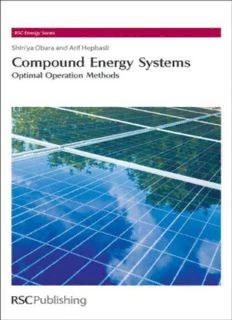Table Of ContentCompound Energy Systems
Optimal Operation Methods
RSC Energy Series
Series Editor:
JulianHuntFRS,UniversityCollegeLondon,London,UK
Titles in the Series:
1:HydrogenEnergy:ChallengesandProspects
2: Fundamentals of Photovoltaic Modules and its Applications
3: Compound Energy Systems: Optimal Operation Methods
How to obtain future titles on publication:
Astandingorderplanisavailableforthisseries.Astandingorderwillbringdeliveryof
eachnewvolumeimmediatelyonpublication.
For further information please contact:
Book Sales Department, Royal Society of Chemistry,
Thomas Graham House, Science Park, Milton Road, Cambridge,
CB4 0WF, UK
Telephone:+44(0)1223420066,Fax:+44(0)1223420247,Email:[email protected]
Visit our website athttp://www.rsc.org/Shop/Books/
Compound Energy Systems
Optimal Operation Methods
Shin’ya Obara
Department of Electrical and Electronic Engineering, Kitami Institute of
Technology, Hokkaido, Japan
Arif Hepbasli
Mechanical Engineering Department, Ege University, Bornova, Izmir, Turkey
RSCEnergySeriesNo.3
ISBN: 978-1-84973-031-0
ISSN: 1757-6741
AcataloguerecordforthisbookisavailablefromtheBritishLibrary
rShin’yaObaraandArifHepbasli2010
Allrightsreserved
Apartfromfairdealingforthepurposesofresearchfornon-commercialpurposesorfor
privatestudy,criticismorreview,aspermittedundertheCopyright,DesignsandPatents
Act1988andtheCopyrightandRelatedRightsRegulations2003,thispublicationmaynot
bereproduced,storedortransmitted,inanyformorbyanymeans,withouttheprior
permissioninwritingofTheRoyalSocietyofChemistry,orthecopyrightowner,orinthe
caseofreproductioninaccordancewiththetermsoflicencesissuedbytheCopyright
LicensingAgencyintheUK,orinaccordancewiththetermsofthelicencesissuedbythe
appropriateReproductionRightsOrganizationoutsidetheUK. Enquiriesconcerning
reproductionoutsidethetermsstatedhereshouldbesenttoTheRoyalSocietyof
Chemistryattheaddressprintedonthispage.
TheRSCisnotresponsibleforindividualopinionsexpressedinthiswork.
PublishedbyTheRoyalSocietyofChemistry,
ThomasGrahamHouse,SciencePark,MiltonRoad,
CambridgeCB40WF,UK
RegisteredCharityNumber207890
Forfurtherinformationseeourwebsiteatwww.rsc.org
Preface
Reduction of an environmental impact with energy consumption is an impor-
tant issue in the world. However, since renewable energy is unstable, in many
cases, it requires support by the conventional energy equipment using a fossil
fuel. In order to increase the utilization rate of renewable energy, investigation
of two methods is required. One is the development of highly efficient energy
storage equipment represented by a battery and heat-storage tank. Another is
development of the operation optimization technology of the compound
energy system including green energy. It is thought that the energy supply
method shifts from the individual operation of large-scale plant to distribution
of small equipment. The change of such an energy supply method can intro-
duce the optimal energy system into a region. As a result, it becomes possible
to arrange the smallest energy system of an environmental impact. The way of
thinking of this technology is connected with a microgrid or a smart grid. A
microgrid and a smart grid require fusion of energy technology and an infor-
mation technology. For example, the operation in consideration of the green
energy change with load prediction and weather prediction of a compound
energy system can be planned. Moreover, we should aim at realization of the
Nature-grid that consists of green energy and information technology. This
book describes the operation optimization technology by compound utilization
of a fuel cell, photovoltaics, wind-power generation, hydrogenation engine,
solar reformer, diesel power plant, etc. The technology described in this book
plays a large rolein the development of a small-scale power-generation system,
a microgrid, and a smart grid, which are introduced into individual houses,
apartment houses or local area power supplies. Further, the exergy analysis
method, which is a very useful tool and has recently gained greater importance
in the design, analysis, simulation and performance evaluation of various
energy systems, isalso included to deduce the potential for improvement.
Shin’ya Obara
Arif Hepbasli
RSCEnergySeriesNo.3
CompoundEnergySystems:OptimalOperationMethods
ByShin’yaObaraandArifHepbasli
rShin’yaObaraandArifHepbasli2010
PublishedbytheRoyalSocietyofChemistry,www.rsc.org
v
Contents
Chapter 1 Background 1
Shin’ya Obara
1.1 Distributed Energy System 1
1.2 Independent Microgrid 2
1.3 Distribution Plan of Energy System 2
References 2
Chapter2 OperationAnalysisofaCompoundEnergySystem–Exhaust
HeatUsePlanwhenConnectingSolarModulestoaFuelCell
Network 5
Shin’ya Obara
2.1 Introduction 5
2.2 The Fuel Cell Energy Network with Solar Modules 6
2.2.1 Urban Area Model 6
2.2.2 Characteristic of the Solar Module 7
2.2.3 Hot-Water Piping Network 10
2.2.4 Facility Scheme 11
2.3 The Path Plan of a Hot-Water Piping Network 13
2.3.1 Heat-Transport Model of a Hot-Water Piping
Network 13
2.3.2 Heat-Transfer Model of Hot-Water Piping 13
2.3.3 Heat Energy Balance 16
2.3.4 Analysis Method 16
2.3.5 Analysis Flow 17
2.4 Case Study 19
2.4.1 Specifications of Hot-Water Piping 19
2.4.2 Analysis Procedure 19
2.4.3 Analysis Conditions and Parameters 20
RSCEnergySeriesNo.3
CompoundEnergySystems:OptimalOperationMethods
ByShin’yaObaraandArifHepbasli
rShin’yaObaraandArifHepbasli2010
PublishedbytheRoyalSocietyofChemistry,www.rsc.org
vii
viii Contents
2.5 Analysis Results 20
2.5.1 Results of the Hot-Water Piping Path in FEN
that Does not Connect Solar Modules 20
2.5.2 InfluencesthatChangesintheOutputofSolar
Modules Have on a Hot-Water Piping
Network 22
2.6 Conclusions 28
Acknowledgments 28
Nomenclature 28
Subscripts 29
The names of buildings 29
References 29
Chapter 3 Operation of Compound Energy System – Fuel Cell
Network System Considering Reduction in Fuel Cell
Capacity 31
Shin’ya Obara
3.1 Introduction 31
3.2 Load Leveling and Arrangement Plan of Fuel
Cell 32
3.2.1 Fuel Cell Network System 32
3.2.2 Power-Generation Characteristics of the Fuel
Cell 35
3.2.3 Load Leveling Using Water Electrolysis 36
3.2.4 Distribution of the Fuel Cell 37
3.2.5 Energy-Balance Equation 38
3.2.6 Operating Method of the System 39
3.3 Analysis Method 40
3.3.1 Procedure of Analysis 40
3.3.2 Solution Parameters 41
3.4 Case Study 42
3.4.1 Energy Demand Pattern and Network
System 42
3.4.2 Reduction Effect of Fuel Cell Facility
Capacity 45
3.4.3 Route Planning Result of Hot-Water
Piping 46
3.4.4 Result of a Fuel Cell Arrangement
Plan 48
3.5 Conclusions 49
Acknowledgments 50
Nomenclature 50
Subscripts 50
References 50
Contents ix
Chapter 4 Power-Independent House UsingPEFC –Operation Planof
a Combined Fuel Cell Cogeneration, Solar Module, and
Geothermal Heat Pump System 52
Shin’ya Obara
4.1 Introduction 52
4.2 FuelCell,SolarModules,andGeothermalHeatPump
Combined System 53
4.2.1 Scheme of Combined System 53
4.2.2 Relational Expression 55
4.2.3 Energy Supply Path 59
4.3 Energy Balance and Objective Function 59
4.3.1 Objective Function of System 59
4.3.2 Multiobjective Optimization 62
4.4 Analysis Results 62
4.4.1 Results of Optimization 62
4.4.2 Equipment Capacity 63
4.4.3 Objective Function and Characteristics of
Operation Plan 69
4.5 Conclusions 71
Acknowledgments 71
Nomenclature 71
Greek Symbols 72
Subscripts 72
References 72
Chapter 5 PEFC/Engine Generator Compound Energy
System (1) – CO Discharge Characteristic of PEFC/
2
Hydrogen-Gas-Engine Hybrid Cogeneration 74
Shin’ya Obara
5.1 Introduction 74
5.2 System Scheme 75
5.2.1 HCGS Model 75
5.2.2 Compression of Reformed Gas 77
5.2.3 Operating Method of System 77
5.2.4 Power-Generation-Efficiency Characteristics
of HCGS 78
5.3 Equipment Characteristics 78
5.3.1 Output Characteristics of NEG 78
5.3.2 Output Characteristics of PEFC 83
5.3.3 Carbon-Dioxide Emission Characteristics of
Boiler 83
5.4 Power and Heat Output Characteristics of HCGS 84
5.4.1 System Operation Map 84
5.4.2 Operation Map of HCGS 86
Description:This book, a distillation of information only touched upon in other books, is aimed at undergraduate and postgraduate students, scientists, engineers and industrialists with an interest in the field.

